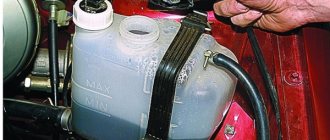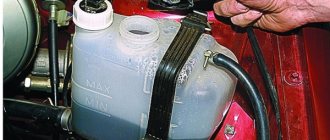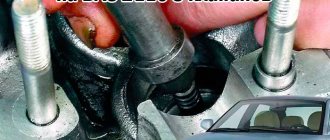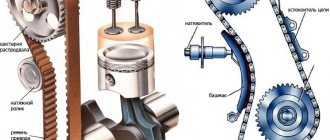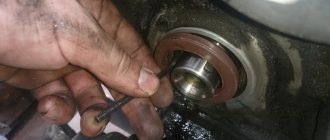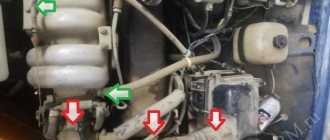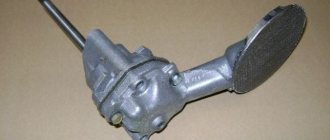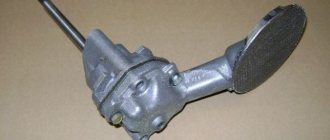Do-it-yourself timing belt replacement
The gas distribution mechanism (GRM) synchronizes the operation of the piston group, the fuel injection system and the exhaust of combustion products.
If you are wondering how to change the timing belt, we will provide the necessary minimum information that will help present this procedure as a whole. This will make it easier to decide whether replacing the timing belt is worth your own efforts, or whether it is better to entrust this work to specialists. The timing belt is the most responsible and important belt drive in a car. Its breakage is a big nuisance. You'll be lucky if the problem is limited to bent valves. Therefore, the answer to the question of how to replace the timing belt should be given immediately as soon as you suspect a problem with its operation. In this case, it is better to play it safe than to have serious repairs in the future.
Recommendations for choosing: which company is better?
Modern belts for gas distribution mechanisms of automobile engines are high-tech products, and therefore not cheap. They are made on the basis of artificial rubber (neoprene, polychlorprene) with various additives, reinforced with a cord of durable threads. The latter are made from fiberglass, nylon and cotton.
This is interesting: They decided to simplify the requirements for trucks and buses imported into Russia
To choose the right new belt, it is suggested to follow these recommendations:
- The best way to avoid making mistakes with the size and shape of the teeth is to take an old belt with you to the store and compare it with the samples offered. Everything must match - length, width, profile of the teeth.
- Don't try to save money by choosing cheaper products. And if your car is used in extreme conditions, then you should choose the best option - the original, in the end it will pay for itself.
- Check the rigidity of the rubber product. The more elastic it is, the longer it will last on the car. Please note: the cheaper the timing belt, the stiffer it is (experts say “oak”).
- Externally, the new product should not have sagging on the teeth (small burrs are allowed), cavities or pores. The surface should be smooth to the touch, not rough.
- If possible, check the catalog number or article number if it is printed on the back of the belt.
It is difficult to follow the listed recommendations when buying a part in an online store. You make such a purchase at your own peril and risk.
Since the auto parts market is saturated with all kinds of counterfeits, there is always a chance of running into a low-quality product. To protect yourself, try to buy a timing belt and pulley at retail outlets from authorized dealers. Original spare parts are sold in sets, sealed in one package.
Set of original parts - belt and two rollers
The most popular manufacturers of belt drives are the Gates and Bosch brands. They are most often counterfeited, so much so that it is quite difficult to distinguish them. The following verification method is practiced: ask to show you several identical products and check the numbers printed on the back. For “correct” belts, combinations of numbers should not be repeated. If the numbers are the same, then you are probably looking at counterfeit products from the Middle Kingdom.
Different numbers are a sign of the authenticity of the product
Where is the timing belt located?
First, let's remember where the timing belt is located and what it looks like. Its location is in front of the engine, but do not forget that motors come in longitudinal and transverse locations. In most cases, gas distribution mechanisms use a toothed rubber belt, but in a considerable number of car models from different manufacturers, a steel chain is also used for this.
Engine cylinders can be equipped with two or four valves with one and two camshafts (CV), respectively. The kinematics of the gas distribution mechanisms of such engines differ. We will show them using the example of 8- and 16-valve power units for the VAZ 2110, 2111 and 2112.
The scheme with two shafts is more complicated, and in it, in addition to the pulley of the second RV, a support roller is added. This also complicates the belt replacement procedure. It is most difficult to perform this operation after a break or severe stretching of the belt, when the factory timing settings can be completely lost. Replacing in normal mode is not so difficult that you can’t try to do it yourself.
What is needed to replace the timing belt
The leading link of the gas distribution mechanism is the crankshaft. It sets the pace of operation of the timing belt. Rotation at high speed and friction forces lead to fairly rapid stretching and wear of the belt. However, the decision about what to change when replacing the timing belt is made after a careful inspection of the mechanism.
It is checked for the presence of play in the tension and support rollers, the absence of oil leaks, and the serviceability of the water pump, the drive (pulley) of which is part of the timing belt, is determined. Therefore, when repairing the gas distribution mechanism, you may need more than just a belt. To replace it, you will definitely need the following set of tools:
- a set of open-end, socket and ring wrenches Nos. 10, 13, 17, including a special fork wrench for fixing the tension roller;
- a torque wrench for tightening the nuts with the required force;
- a device for checking belt tension;
- screwdrivers;
- jack.
Before you begin replacing the timing belt, you should prepare the vehicle. First of all, the car needs to be fixed so that it does not rock back and forth. Remove the front right wheel and the protection under it, as well as other parts that may cause you inconvenience when working. After removing the protection, return the wheel to its place. It is most convenient to combine marks and marks on timing pulleys and engine body parts.
How to remove and replace a belt drive
The main rule that is important to follow when replacing the belt is not to disturb the valve timing, which is achieved by aligning the marks on the gears, crankshaft flywheel and engine housing. During the work process, you need to check that the marks do not move. The procedure is divided according to the following scheme:
- Disassembling the unit and removing the old belt.
- Visual inspection of the mechanism parts and cleaning the internal cavity from dirt.
- Installing a new belt with a roller, tensioning it.
- Assembly and performance testing.
In most cases, you can install a new drive without any special tools. The exception is 16-valve engines, where it is recommended to use jigs to fix the camshafts, but in extreme cases you can do without them. The standard set of tools is as follows:
- jack and wheel wrench;
- open-end wrenches, spanners, heads with extension;
- screwdriver, pliers with pointed ends;
- flashlight for illumination.
Camshaft Locking Tool
It is easier to work with some car models from the inspection pit, but it is usually not required to replace the timing belt. The work procedure is different for 8 and 16 valve engines, so they should be considered separately. An example is the family of front-wheel drive VAZ cars.
Procedure for working on an engine with 8 valves: step-by-step instructions with photos
First, you need to park the car on a level area or inspection hole and secure it with the hand brake. Then unscrew and remove the front wheel from the timing assembly side by lifting the car on a jack. Perform further actions in this order:
- Remove the plastic cover covering the drive from above.
- Remove the elements that block access to the lower cover of the gas distribution mechanism - mud flaps, anthers, crankcase protection. Loosen and remove the generator drive belt, remove the cover.
- Use a powerful screwdriver or a mounting spatula to wedge the crankshaft by inserting it between the teeth of the flywheel. Using an open-end wrench, loosen the bolt holding the pulley at the end of the crankshaft. Remove the pulley and screw the bolt back into the hole.
- Release the crankshaft and rotate it with a wrench by the bolt until the marks align. The marks on the housing, gears and flywheel must match. To be sure, jam the crankshaft again.
- Loosen the tension pulley nut and remove the loose old belt. Next, remove the roller.
- Inspect the pump and seals for leaks and thoroughly wipe the mechanism cavity from dirt.
Aligning marks
Advice. As a rule, the pulley bolt is too tight and loosening it is problematic. Have a helper engage first gear and press the brake pedal while you remove the bolt.
The belt is put on the gears in a counterclockwise direction
. Before installing the new belt drive, install the tension roller and tighten the nut without tightening it. Then slide the belt over the gears so that all the slack is on the tension pulley side. Be careful not to disturb the position of the marks.
The tension is checked by turning the strap around its own axis
The next step is to tighten the belt using a roller. You need to insert pliers into its holes and turn it on an eccentric axis, then tighten the nut. The timing belt is considered to be normally tensioned if it cannot be manually rotated around its axis by more than 90°. After tensioning, reassembly and a test run of the motor are performed.
This is interesting: How to choose a car radio?
How to change a belt: video
Replacement on a 16-valve engine
The 16V engine has 2 camshafts that open their pairs of valves with cams. This gives rise to a number of differences in the process of replacing a belt drive:
- after initial disassembly, you need to align the marks on both camshafts;
- the camshafts are fixed with a special device - a jig; in VAZ cars it is a bar with cutouts inserted into the slots at the ends of these shafts;
- in addition to the tension roller, the mechanism has a second roller - a parasitic (support) roller, which also needs to be changed;
- When putting on the belt, you need to monitor the position of the marks and tighten it as much as possible with your hands so that the slack is on the side of the movable roller.
Marks on the 16V motor
Tensioning is also done by turning the eccentric roller and fixing it with a nut. In VAZ cars, a mark is stamped on the roller body, which is aligned with the boss on the body when the belt is tensioned. Having achieved the desired tension, be sure to make 2-3 full revolutions of the crankshaft by hand, and then re-check the position of the marks. In general, the procedure remains the same as when working with an 8V motor.
Video about working with a 16V engine
What else do you need to know about replacing the timing belt?
When changing the timing belt drive, you need to pay attention to the condition of all its parts. If an oil leak is detected from the crankshaft or camshaft oil seal, it is advisable to take the opportunity to change the seal. The problem is that not everyone can do such work on their own, so it is better to detect the leak before disassembling the unit.
The meaning is this: the employees of the car service center where you bring your car to replace the oil seal will still remove the timing belt, otherwise you won’t be able to get to it. And if so, then they will include the operation of removing and tensioning the belt drive in the cost of repairs. There is no point in changing the belt yourself if the service station will do the same and charge you for it.
The block wall is in oil - the oil seal is leaking
The same goes for the water pump, which is clearly leaking antifreeze due to a broken bearing. A sure sign of a malfunction is that the entire space of the timing belt assembly and its parts are covered with moisture thrown by the belt. If you are not able to change the pump yourself, then there is no need to disassemble the car; it is better to immediately go to a car service center.
Advice. A leaking pump must be replaced immediately, regardless of the condition of the belt and other timing elements.
It often happens that a belt breaks while on the road, and the car owner has a spare one in the trunk. Since it will not be possible to move further under our own power, you can install a new spare part in the field under the following conditions:
- the break did not lead to bending of the valves;
- the necessary tools are available;
- There is a way to move your car off the road and park it on level ground.
The replacement process is similar to that described above, only in a 16-valve engine you will have to do without fixing the camshafts. It is important to carefully set the marks and not allow them to move, and after installing and tensioning the belt, double check their position before starting the engine.
Advice. When replacing, you should not treat the new rubber product with any chemicals. It is intended to be installed and operated in its original form, but may begin to slip due to exposure to chemicals.
Do-it-yourself timing belt replacement
Here we suggest looking at a photo report on how to change the timing belt on a VAZ with a 16-valve engine. The procedure is performed in the following sequence of actions:
- Remove the alternator belt from the pulley on the crankshaft.
- Remove the timing belt guard cover.
- Align the marks of the RV pulleys according to the marks on the casing.
- Remove the generator drive pulley, check again and set the marks, adding the crankshaft to this, after which you can remove the tension roller, and after it the belt.
- Check the condition of the belt and rollers.
- Reinstall the belt.
- Install the tension roller.
- Tension the belt.
- Finally check the correspondence of the labels.
- Perform a test run of the engine and complete assembly.
Timing belt tension: algorithm of actions
The timing belt is an element in the engine design that connects the camshaft and crankshaft, organizing the timely opening and similar closing of the valves. The belt drive must always be well tensioned; as a result, engineers have introduced special tensioners into the design of the gas distribution mechanism. Few people know, but not only the service life of the belt itself, but also the unit as a whole depends on proper tension settings. We will talk in more detail about how to tighten the timing belt, and when such an operation may be required, in the article given today.
How to choose a part
When choosing timing belts, they rely on several main criteria:
Today, car stores offer a wide range of timing belts, which makes it difficult for many car owners to decide on a specific model.
Products made in Europe are considered to be of the highest quality. This is explained by strict quality control of parts manufactured in European factories: every stage of production is checked, from the selection of raw materials to the inspection of the finished part. For this reason, many car owners highly value Gates brand mechanism belts.
Some of the highest quality timing belts are produced under the Gates brand
Table: the most popular brands of timing belts according to domestic car enthusiasts
| Manufacturer | Manufacturer information |
| Dayco | A company from Italy engaged in the production of hinges, drive belts and roller mechanisms. |
| Gates | One of the market leaders in the production and sale of drive belts. Products under the brand name of this manufacturer are found not only in the automotive industry, but also in agriculture, metallurgy, and in the field of computer technology. The company is located in Belgium. |
| Contitech | A group of manufacturers whose products are installed directly into new cars when they are assembled. In addition, the company is engaged in the manufacture of air suspension mechanisms, drive systems, technical fluids and accessories and parts for car interiors. German company. |
| Bosch | The most famous and oldest German company specializing in the production of automotive parts, construction and garden equipment, power tools and household appliances. The company is located in Gerlingen, Germany. |
| Lemforder | Many car enthusiasts are familiar with the company under the name ZF. Manufactures suspensions, drives, transmissions and steering systems. Country of origin: Germany. |
| Balakovo | Domestic manufacturer of rubber products, specializing in the production of various household parts, mineral and chemical mixtures. The plant is located in the city of Balakovo. The parts he produces are extremely popular among domestic car enthusiasts. |
A few words about the importance of correct tension
Many motorists know that improper functioning of the timing belt can cause very serious engine damage. This is due to the principles of operation of the mechanism, which boil down to the timely and high-quality opening/closing of the engine valves. This approach not only allows you to adjust the valve timing of the internal combustion engine, but also differentiates between sensitive valves and constantly knocking pistons.
If the timing belt begins to work incorrectly, the gas distribution order is disrupted, as a result of which engine elements begin to wear out at an accelerated rate. Similar disturbances in the functioning of the engine can also occur due to improper belt tension.
Note! A break in the belt drive while driving not only negatively affects the condition of the engine, but can actually severely bend the valves. Repairing a car with such a breakdown often costs motorists five-digit sums of money.
In addition, drive tension that does not meet the standards accelerates wear of the main timing elements, the list of which includes:
- directly the belt drive itself;
- rollers;
- torque clutches;
- guides;
- tensioner
Repair of each of the marked timing parts takes much longer than normal belt tensioning. Well, there is nothing to say about the cost, if you can tighten the drive yourself and completely free of charge, then you will have to pay for replacing the components of the mechanism.
About the timing and frequency of replacement according to the regulations
The exact frequency of replacing the timing belt drive is indicated in the operating instructions supplied with each vehicle. It also indicates whether the tension roller needs to be changed at the same time as the belt. As a rule, it is also replaced with a new one.
As already mentioned, the service life of products depends on the brand of car and lies in the range of 50-150 thousand km. But the condition of the timing drive should be periodically monitored and early replacement made in the following cases:
- longitudinal cracks appeared on the back side of the belt;
- the edges of the rubber product are “frayed”, threads from the cord stick out from it;
- if there are transverse cracks on the inside between the teeth;
- the teeth began to peel off or were noticeably worn out, and the parts of the mechanism and the walls of the casing were covered with black rubber dust.
Transverse cracks - the first sign
To conduct a visual inspection of the belt drive and assess its condition, simply unscrew and remove the upper protective casing (usually made of plastic). Along the way, it’s worth inspecting all the gears and the walls of the cylinder block, looking for leaks of engine oil or antifreeze from the pump.
Advice. If the engine suddenly begins to operate unstably at idle and while driving, and shots appear in the injector receiver and exhaust pipe, then do an emergency inspection of the timing drive. These problems arise due to shifted valve timing, which is caused by a loose belt that has jumped 1-2 teeth.
When does the belt need to be tightened?
Having considered the previous paragraph of the article, it was probably not difficult to understand that monitoring the correct functioning of the timing belt is quite important. In particular, it is worth keeping the belt drive tension at the proper level. By the way, stretching is carried out only in two main cases:
- During a routine check of the gas distribution mechanism and the tension does not comply with the norm. The normal tension of the timing belt is checked in a very simple way, for which you will need ordinary spring scales and a ruler or caliper. To check, the hook of the scale clings to the belt and pulls until the display shows a load of 10 kilograms. Without loosening your grip, all that remains is to measure the deviation of the drive from the normal position. If the belt has been pulled back by more than 5.5 millimeters, but its tension is inevitable. Otherwise, you can leave everything as is until the next timing check, which is recommended every 10-15,000 kilometers;
- When repairing the timing belt, when the belt was removed or its tension was weakened.
In situations that do not correspond to those noted above, it is simply not worth touching the belt drive of the mechanism. Especially if the motor runs stably, without pronounced problems.

